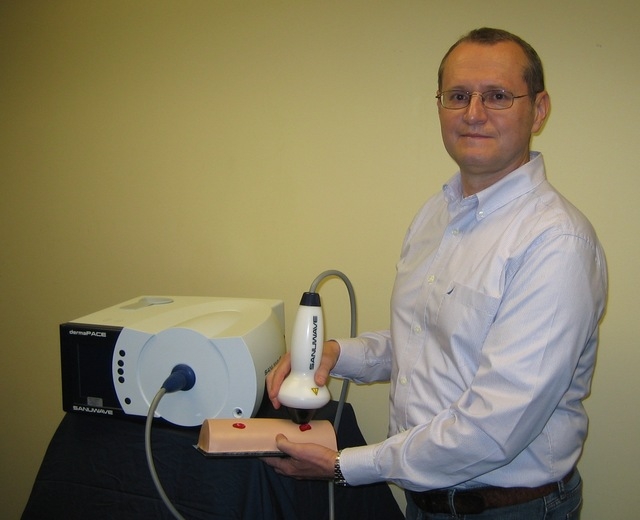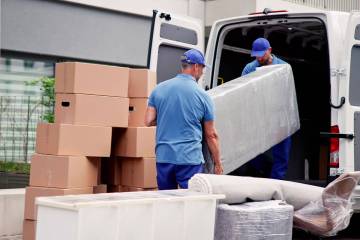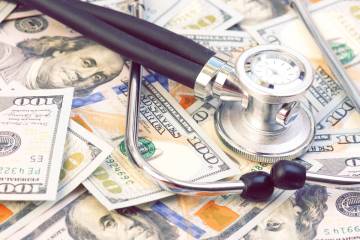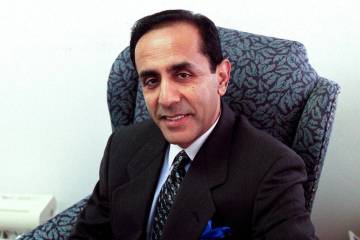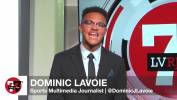Marriage of medicine, technology forecast future of health care
UnitedHealthcare’s Kirk Pion, vice president and innovation champion, says technology has met modern health care.
One of those technologies was at the 2016 CES and helps monitor one’s health. Pion said he sees the fitness tracker and remote monitor as the next step in integrating an individual’s daily life with information the doctor can use.
CES is an international consumer electronics show that was formerly called the Consumer Electronics Show.
“The whole idea behind these innovations is to help people in between times when they see their doctor or have a health event that requires them to seek care,” Pion said. “… They (doctors) don’t need to know what you’re doing every single minute, but I think it’s important to determine what level of information to share with them.”
What would people like to see come to market?
Adin, who asked that his last name not be used, works at Bambino’s East Coast Pizzeria, 2555 S. Durango Drive. He’s on his feet all day and said he’d like a bed that could cuddle him and “regulate my sleep. I’m a restless sleeper, and I wake myself up a lot. I need something that’ll help me relax. People say to play music, but that just irritates me.”
Another innovation on the CES floor tracked various aspects of a person’s life with a single app: steps, blood monitoring, weight and nutritional intake.
Pion said the public will see new items coming on board such as a smart toothbrush that helps monitor brushing habits and beds designed to help one sleep better by adjusting to their particular sleeping habits and needs.
The advancement in 3-D printing also has made a big impact on medical devices. Prototypes that used to take weeks to create can be printed in hours, saving time and money. It’s also being used to help surgeons in training before they start operating on real patients.
There have also been advances in how diabetes is treated. For those who develop foot ulcers — a common occurrence after the lower extremities go numb — dermaPACE, available through SANUWAVE Health Inc., has been developed. It’s shockwave technology for the non-invasive treatment of chronic wounds and other conditions that stem from tissues with insufficient blood flow. The dermaPACE was used in the international market almost as soon as it premiered at the 2009 Symposium on Advanced Wound Care convention. The company expects FDA approval in the latter half of 2016.
“Shock wave treatments began with treating kidney stones,” said Kevin Richardson, SANUWAVE chairman and CEO. “Way back when, you would sit in a bath of water and the (instrument) would be placed near you and the waves broke up the kidney stones and you’d pass them. But then they realized other things were happening. Wounds were healing faster. Infections were going away. It spurred the industry to come up with new (applications).”
Some of those new applications involve tendinopathies and Alzheimer’s, with research in Vienna to see how shock waves affect TLC 3 and 4 receptors. Another conversation in the medical community is how it might attack cancer.
Richardson’s own company has done work with killing viruses and is now applying it to blood sterilization through an effort in conjunction with researchers at the University of Georgia.
“Like the Zika virus, we won’t have anything to report yet, but in theory, using shock waves, we should be able to kill it,” Richardson said.
Some advancements take their cues from science fiction movies and shows such as “Star Trek.” Today, your temperature is taken by a device that’s waved across your forehead. Retina chips are another Star Trek “invention,” so to speak, used to treat retinitis pigmentosa.
Also, inoculating patients doesn’t always require a needle. MIT has already created a hypospray injection that can be forced under the skin with high air pressure with a device called a jet injector. The air pressure shoots the liquid vaccine deep enough into the skin that no needle is required. Since jet injection systems can utilize a larger container for the vaccine, more people can be inoculated faster.
Richardson said inventions often come from speaking with doctors to learn where there is a need.
“There’s a lot of good data out here,” he said, “and we’re only now just starting to scratch the surface of these things.”
Not everything at CES was technology-driven. Author and alternative medicine advocate Deepak Chopra did a session on genetics, an area likely to be evolving over the next few years.
“People think that they’re born with their genes and whatever you get is what you’re stuck with. But what they’re learning is that environment impacts the genetic profile,” Pion said. “What you do has the potential to change the way your genes behave. … It gets you excited about the future.”
To reach Summerlin Area View reporter Jan Hogan, email jhogan@viewnews.com or call 702-387-2949.



